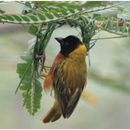en
names in breadcrumbs


This endemic resident occurs in swamps and riverine vegetation in the Lufira river valley in the vicinity of Lake Tshangalele in DR Congo.
The breeding season is from February to March; the male builds a elaborately woven nest for a female.
IUCN Red List Status: Data Deficient (DD)
The Lufira Masked Weaver is previously only known from the unique type specimen collected in 1960 at Lake Lufira (= Lake Tshangalele) in Katanga (Democratic Republic of Congo). For many years the status of Ploceus ruweti remained obscure, until it was rediscovered nesting at the same locality in February–March 2009.
The males of this sexually dimorphic ploceid are yellow and rufous coloured with a black mask differing from other members of the P. velatus complex by some detailed diagnostic characteristics.
Preliminary results reveal that Lufira Masked Weaver is a member of the P. velatus complex (Louette & Hasson 2009). Preliminary DNA sequence data of the mitochondrial cytochrome oxidase 1 gene (COI) show a low sequence divergence between P. ruweti on the one hand and several P. velatus sensu strictu (<1%) and P. jacksoni (<0.5%) on the other hand, as well as between P. velatus and P. jacksoni (<1%) (Craig et al. 2011). Interspecific sequence divergence between the P. ruweti/velatus/jacksoni group and other Ploceus species (including P. vitellinus uluensis, P. katangae, P. upembae and P. reichardi) are markedly higher (>2% up to 11%; unpublished data). Concerning the species status of Ploceus ruweti, the data available confirm that it is a valid species, since both P. jacksoni and P. velatus are morphologically and ecologically distinct, with entirely allopatric distribution ranges (Craig et al. 2011). Current comparative molecular studies by JEMU at the Royal Museum for Central Africa will hopefully clarify the relationships of these species within the genus Ploceus.
Probably in the Lake Lufira valley between Lake Lufira and Kiubo Falls, although observations are lacking from the intervening stretch of river (Craig et al. 2011). Local inhabitants claim that the birds are observed away from the Lake Lufira in the latter half of the dry season, in July–October (Louette & Hasson 2009).
Reportedly common in 1960 (within its tiny range in the vicinity of Lake Lufira), rediscovered nesting (at the same locality) in 2009 (Louette & Hasson 2009), and resighted (there as well as near Kiubo Falls) in 2010 (Craig et al. 2011)
The Lufira masked weaver (Ploceus ruweti), also known as Ruwet's masked weaver or the Lake Lufira weaver, is a species of bird in the weaver family, Ploceidae. It is endemic to the Democratic Republic of the Congo. Its natural habitat is swamps in the south-east part of the country. It is sometimes regarded as a subspecies of the Tanzanian masked weaver.
The Lufira masked weaver (Ploceus ruweti), also known as Ruwet's masked weaver or the Lake Lufira weaver, is a species of bird in the weaver family, Ploceidae. It is endemic to the Democratic Republic of the Congo. Its natural habitat is swamps in the south-east part of the country. It is sometimes regarded as a subspecies of the Tanzanian masked weaver.